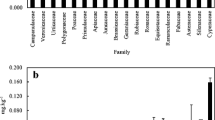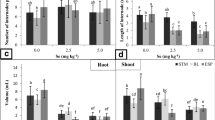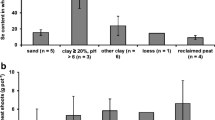Abstract
High levels of naturally occurring selenium (Se) are often found in conjunction with different forms of salinity in central California. Plants considered for use in phytoremediation of high Se levels must therefore be salt tolerant. Selenium accumulation was evaluated for the following species under increasing salt (NaCl and CaCl) conditions:Brassica napus L. (canola),Hibiscus cannibinus L. (kenaf),Festuca arundinacea L. (tall fescue), andLotus tenuis L. (birdsfoot trefoil). The experimental design was a complete randomized block with four salt treatments of <1, 5, 10, and 20 dS m-1, four plant species, three blocks, and six replicates per treatment. Ninety days after growing in the respective salt treated soil with a Se concentration of 2 mg Se kg-1 soil, added as Na2SeO4, all plant species were completely harvested. Among the species tested, shoot and root dry matter yield of kenaf was most significantly (p<0.001) affected by the highest salt treatment and tall fescue and canola were the least affected species. Generally there was a decrease in tissue accumulation of Se with increasing salt levels, except that low levels of salinity stimulated Se accumulation in canola. Canola leaf and root tissue accumulated the highest concentrations of Se (315 and 80 mg Se kg-1 DM) and tall fescue the least (35 and 7 mg Se kg-1 DM). Total soil Se concentrations all harvest were significantly (p<0.05) lower for all species at all salt treatments. Removal of Se from soil was greatest by canola followed by birdsfoot trefoil, kenaf and tall fescue. Among the four species, canola was the best candidate for removing Se under the tested salinity conditions. Kenaf may be effective because of its large biomass production, while tall fescue and birdsfoot trefoil may be effective because they can be repeatedly clipped as perennial crops.
Similar content being viewed by others
References
Anderson J W and Scarf A R 1983 Selenium and plant metabolism.In Metals and Micronutrients: Uptake and Utilization by Plants. Eds. D A Robb and W S Pierpoint. pp 241–275. Academic Press, Inc., London, UK.
Ayars J E, Hoffman G H and Phene C J 1987 Irrigation systems and management alternatives for reducing drainage from irrigated agriculture. Proc. U.S. Committee on Irrigation and Drainage, Sacramento, CA, USA. Nov. 1987.
Bañuelos G and Akohoue S 1994 Comparison of wet digestion and microwave digestion on selenium and boron analysis in plant tissues. Commun. Soil Sci. Plant Anal. 25, 1655–1670.
Bañuelos G S, Cardon G E, Phene C J, Wu L, Akohoue S and Zambrzuski S 1993 Soil boron and selenium removal by three plant species. Plant and Soil 148, 253–263.
Bañuelos G S and Meek D W 1990 Accumulation of selenium in plants grown on selenium-treated soil. J. Environ. Qual. 19, 772–777.
Bell P F, Parker D R and Page A L 1992 Contrasting selenate-sulfate interactions in selenium-accumulating and nonaccumulating plant species. Soil Sci. Soc. Am. J. 56, 1818–1824.
Brown T A and Shrift A 1980 Identification of selenocysteine in proteins of selenate grownV. radiata. Plant Physiol. 66, 758–761.
Brown T A and Shrift A 1982 Selenium: toxicity and tolerance in higher plants. Biol. Rev. Cambridge Philos. Soc. 57, 59–84.
Butler G W and Peterson P J 1967 Uptake and metabolism of inorganic forms of selenium-75 bySpirodela oligorrhiza. Aust. J. Biol. Sci. 20, 77–86.
Dalton F N and Poss J A 1990 Water transport and salt loading: an unified concept of plant response to salinity. Acta Hortic. 1, 187–193.
Davies E B and Watkinson J H 1966 Uptake of native and applied selenium by pasture species. I. Uptake of Se by browntop, ryegrass, cocksfoot, and white clover from atiamuri sand. N. Z. J. Agric. Res. 9, 317–327.
Deverel S J, Gilliom R J, Fujii R, Izbicki J and Fields J C 1984 Areal distribution of selenium and other inorganic constituents in shallow groundwater of the San Luis Drain service area, San Joaquin Valley, California: A preliminary study. U.S. Geologic Survey Water Resources Invest. Rep. 84–4139, US Dept. of the Interior, Denver, CO, USA.
Dhillon K S and Dhillon S K 1991 Selenium toxicity in soils, plants, and animals in some parts of Punjab, India. Int. J. Environ. Stud. 37, 15–24.
Duckart E C, Waldron L J and Donner H E 1992 Selenium uptake and volatilization from plants growing in soil. Soil Sci. 153, 94–99.
FrankenbergerJr. W T and Karlson U 1990 Environmental factors affecting microbial production of dimethylselenide in a selenium-contaminated sediment. Soil Sci. Soc. Am. J. 53, 1435–1447.
Greenway H and Munns R 1980 Mechanisms of salt tolerance in nonhalophytes. Annu. Rev. Plant Physiol. 31, 149–190.
He T and Cramer G R 1992 Growth and mineral nutrition of six rapid-cyclingBrassica species in response to seawater salinity. Plant and Soil 139, 285–294.
Hoagland D R and Arnon D I 1950 Water-culture method for growing plants without soil. Calif. Agric. Exp. Stat. Circ. 347.
Karlson U and Frankenberger W TJr 1988 Determination of gaseous selenium-75 evolved from soil. Soil Sci. Soc. Am. J. 52, 678–681.
La Haye P A and Epstein E 1969 Salt toleration by plants, enhancement with calcium. Science 166, 395–396.
Lauchli A and Epstein E 1970 Transport of potassium and rubidium in plant roots: The significance of calcium. Plant Physiol. 45, 639–649.
Lawrence Berkeley Laboratory 1988 Hydrological, geochemical, and ecological characterization of Kesterson Reservoir: Annual Report, Oct. 1, 1987–Sept. 30, 1988. LBL-26438. Earth Sciences Division, Lawrence Berkeley Laboratory, Univ. of California, Berkeley, USA.
Leggett J E and Epstein E 1956 Kinetics of sulphate absorption by barley roots. Plant Physiol. 31, 222–226.
Mikkelsen R L, Bingham F T and Page A L 1988 Factors affecting selenium accumulation by agricultural crops.In Selenium in Agriculture and the Environment. Ed. L W Jacobs. SSSA Spec. Publ. 23. ASA and SSSA, Madison, WI, USA.
Ohlendorf H M, Oldfield J E, Saika M K and Aldrich T W 1986 Embryonic mortality and abnormalities of aquatic birds: apparent impacts by selenium from irrigation drain water. Sci. Total Environ. 52, 49–63.
Parker D R, Page A L and Thomas D N 1991 Salinity and boron tolerances of candidate plants for the removal of selenium from soils. J. Environ. Qual. 20, 157–164.
Phene C J, McCormick R L, Davis K R, Pierro J and Meek D W 1989 A lysimeter feedback system for precise evapotranspiration measurement and irrigation control. Trans. ASAE 32, 477.
Presser T S, Sylvester M A and Law W H 1994 Bioaccumulation of selenium in the west. Environ. Manage. 18, 423–436.
Rains D W, Croughan T D and Stavarek S J 1979 Selection of salt-tolerant plants using tissue culture.In Genetic Engineering of Osmoregulations: Impact on Plant Productivity for Food, Chemicals and Energy. Eds. D W Rains, R C Valentine and A Hollaender. pp 279–292. Plenum Press, New York, USA.
Retana J, Parker D R, Amerhein C and Page A L 1993 Growth and trace element concentrations of five plant species grown in highly saline soil. J. Environ. Qual. 22, 805–811.
Rosenfeld I and Beath O A 1964 Selenium, Geobotany, Biochemistry, Toxicity, and Nutrition. Acad. Press, New York, USA.
SAS Institute, Inc. 1985 SAS/STAT guide for personal computers, 6th ed. Statistics. SAS Inst., Inc. Cary, NC, USA.
Shannon M C and C L Noble 1995 Variation in salt tolerance and ion accumulation among subterranean clover cultivars. Crop Sci. 35, 798–804.
Singh M, Singh N and Bhandari D K 1980 Interaction of selenium and sulfur on the growth and chemical composition of rape. Soil Sci. 129, 238–244.
Solutions 1992 Canola needs more Sulfur. Nov/Dec. 38–39. Doane Agric. Services Company, St Louis, MO, USA.
State Water Resources Control Board 1987 Regulation of Agricultural Drainage to the San Joaquin River. SWRCB Order No. WQ: 85–1 Technical Committee Report, Sacramento, CA, USA.
Terry N and Zayed A M 1994 Selenium volatilization by plants.In Selenium in the Environment. Eds. W T FrankenbergerJr. and S Benson. Marcel Dekker Inc., New York, USA.
Terry N, Carlson C, Raab T K and Zayed A M 1992 Rates of selenium volatilization among crop species. J. Environ. Qual. 21, 341–344.
Tokunaga T K, Lyston D S, Benson S M, Yee A W, Oldfather J M, Duckart E C, Johannes P W and Halvorsen K E 1991 Soil selenium fractionation, depth profiles and time trends in a vegetated site at Kersterson Reservoir. Water Air Soil Pollut. 57/58, 31–41.
Wan H F, Mikkelsen R L and Page A L 1988 Selenium uptake by some agricultural crops from central California soils. J. Environ. Qual. 17, 269–272.
Watson F, Bañuelos G and O'Leary J 1993 Trace element composition ofAtriplex species. Agric. Ecosyst. Environ. 48, 157–162.
Weimberg R, Lerner H R and Poljakoff-Mayber A 1984 Changes in growth and water-soluble solute concentrations inSorghum bicolor stressed with sodium and potassium salts. Physiol. Plant. 62, 472–480.
Wu L and Huang Z H 1991 Selenium tolerance, salt tolerance, and selenium accumulation in tall fescue lines. Ecotoxicol. Environ. Saf. 21, 47–56.
Wu L, Huang Z H and Burau R G 1988 Selenium accumulation and selenium-salt co-tolerance in five grass species. Crop Sci. 28, 517–522.
Author information
Authors and Affiliations
Rights and permissions
About this article
Cite this article
Bañuelos, G.S., Zayed, A., Terry, N. et al. Accumulation of selenium by different plant species grown under increasing sodium and calcium chloride salinity. Plant Soil 183, 49–59 (1996). https://doi.org/10.1007/BF02185564
Received:
Accepted:
Published:
Issue Date:
DOI: https://doi.org/10.1007/BF02185564




